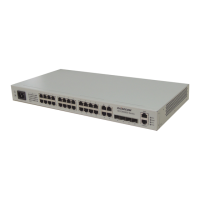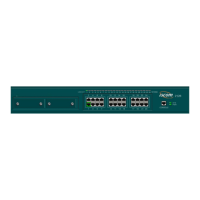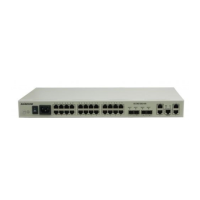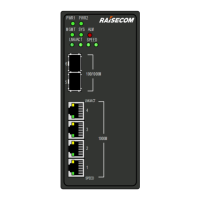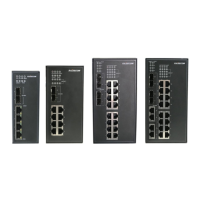Raisecom
ISCOM2600 (B) Series Product Description
Raisecom Proprietary and Confidential
Copyright © Raisecom Technology Co., Ltd.
Link-state tracking provides an interface linkage scheme,
extending the range of link backup. Through monitoring uplinks
and synchronizing downlinks, faults of the upstream device can
be transferred quickly to the downstream device, and
primary/backup switching is triggered. In this way, it avoids
traffic loss because the downstream device does not sense faults
of the upstream link.
In this fiber, multi-mode optical signals are transmitted.
A network security mechanism, used to solve problems of
network delay and congestion. When the network is overloaded
or congested, QoS can ensure that packets of important services
are not delayed or discarded and the network runs high
efficiently. Depending on the specific system and service, it may
relate to jitter, delay, packet loss ratio, bit error ratio, and signal-
to-noise ratio.
802.1Q in 802.1Q (QinQ), also called Stacked VLAN or Double
VLAN, is extended from 802.1Q and defined by IEEE 802.1ad
recommendation. This VLAN feature allows the equipment to
add a VLAN tag to a tagged packet. The implementation of
QinQ is to add a public VLAN tag to a packet with a private
VLAN tag, making the packet encapsulated with two layers of
VLAN tags. The packet is forwarded over the ISP's backbone
network based on the public VLAN tag and the private VLAN
tag is transmitted as the data part of the packet. In this way, the
QinQ feature enables the transmission of the private VLANs to
the peer end transparently. There are two QinQ types: basic
QinQ and selective QinQ.
It is an Asynchronous Transfer Mode (ATM), which does not
contain hand-shaking signals. It can carry on point-to-point
communication with RS232 and RS422 of other stations,
featuring transparent transmission, with a maximum rate of 19.2
Kbit/s. Generally, the form of RS232 interface is DB9 or DB25.
Remote
Authentication Dial In
User Service
(RADIUS)
RADIUS refers to a protocol used to authenticate and account
users in the network. RADIUS works in client/server mode. The
RADIUS server is responsible for receiving users' connection
requests, authenticating users, and replying configurations
required by all clients to provide services for users.

